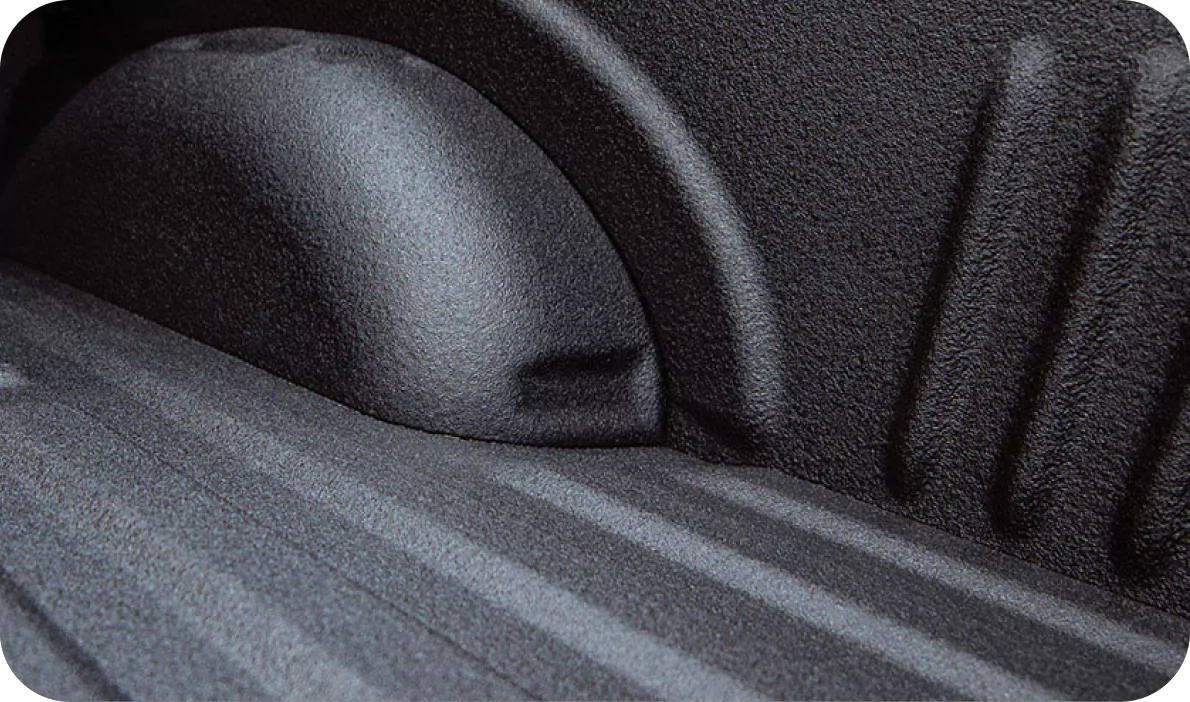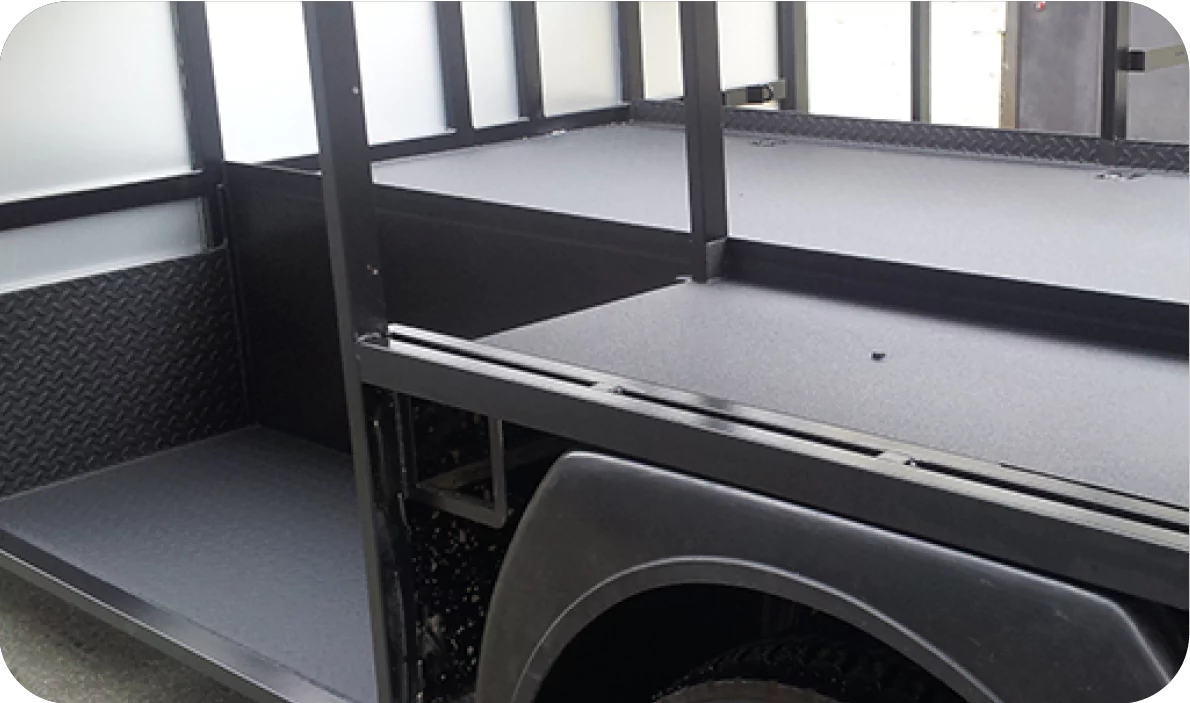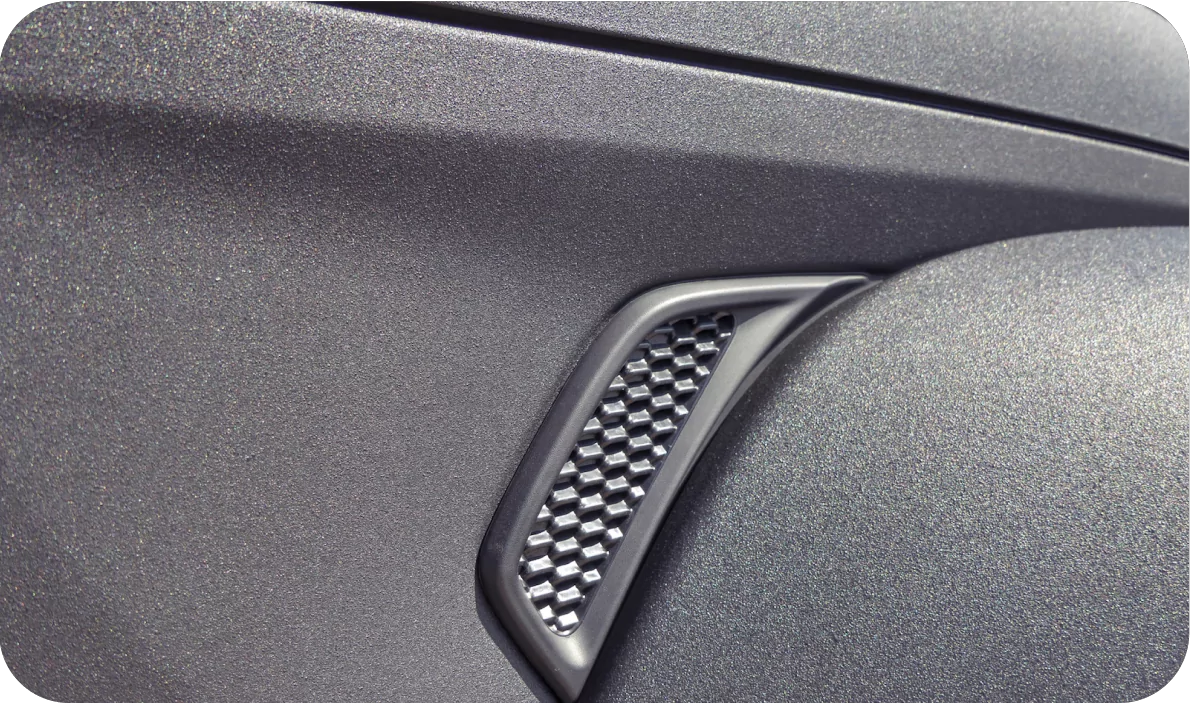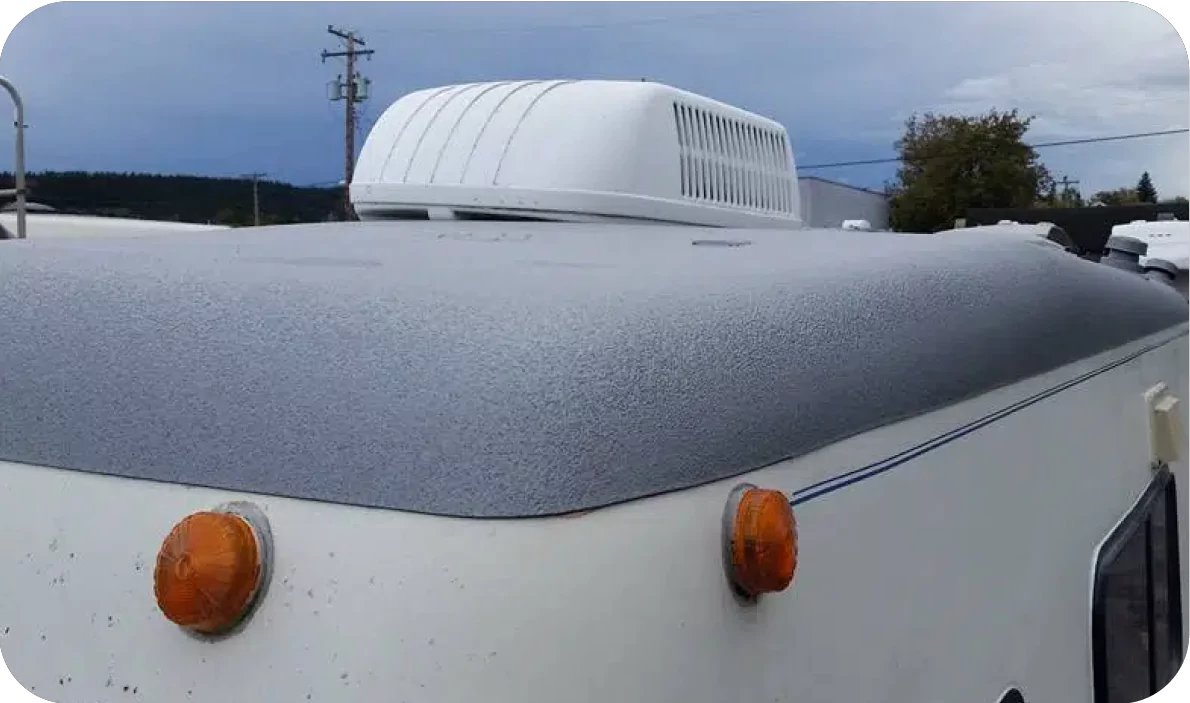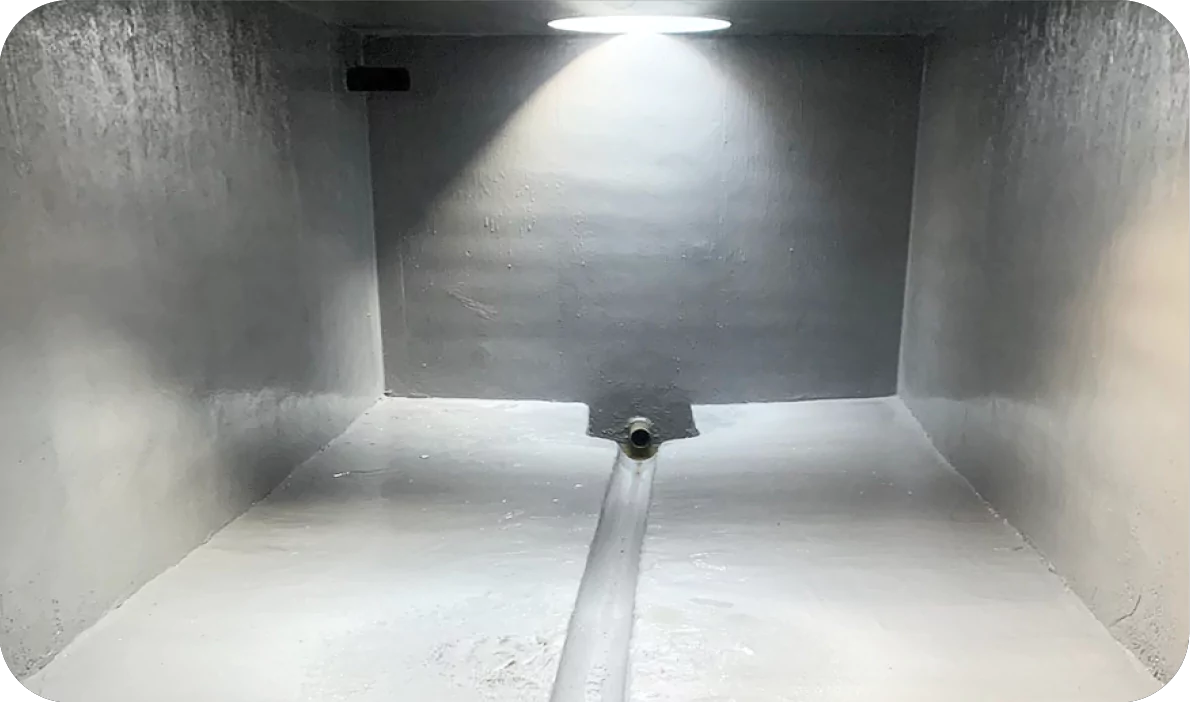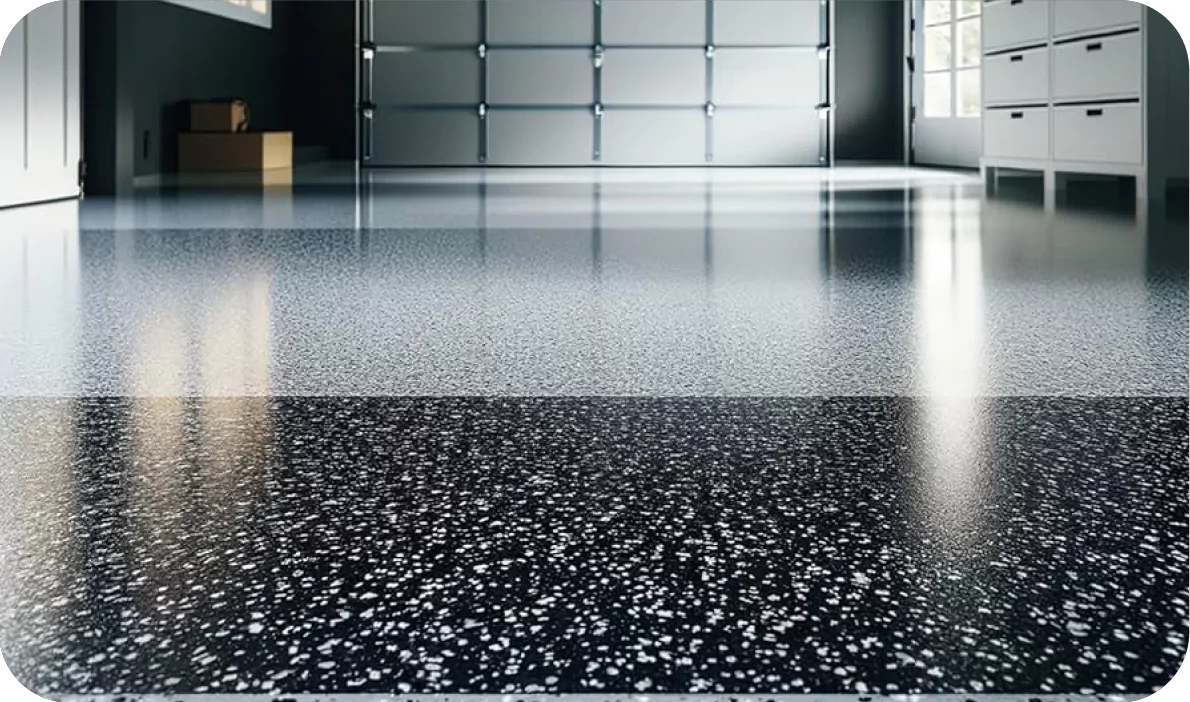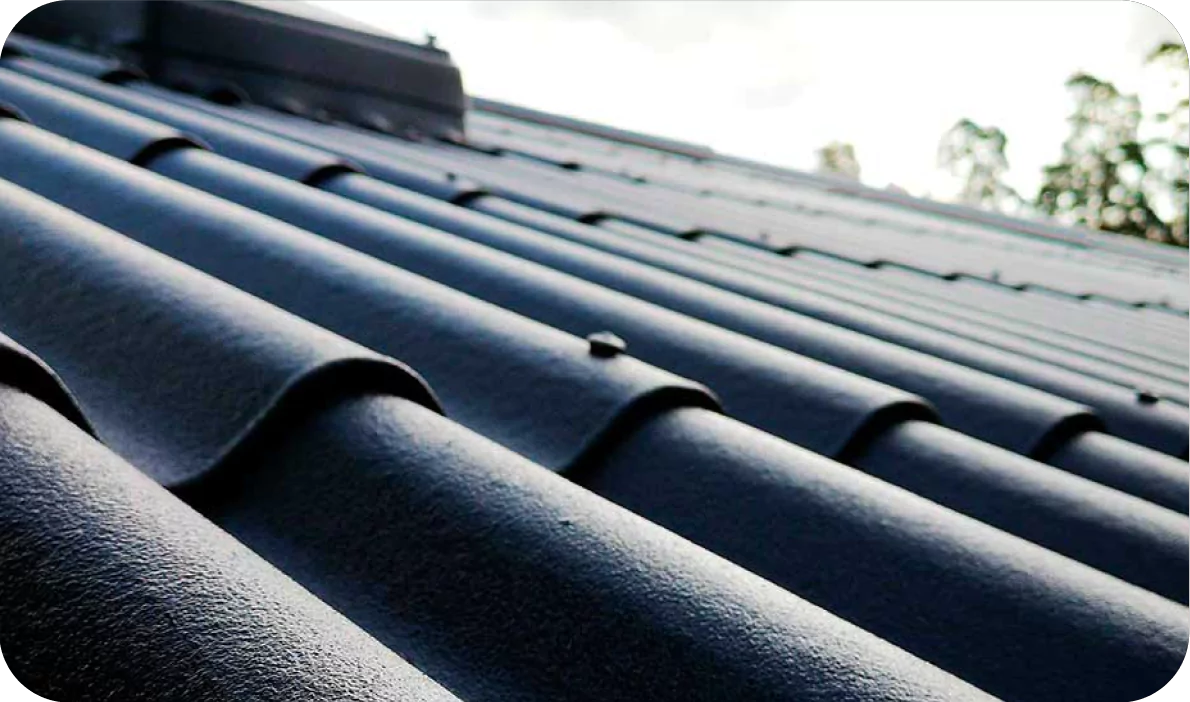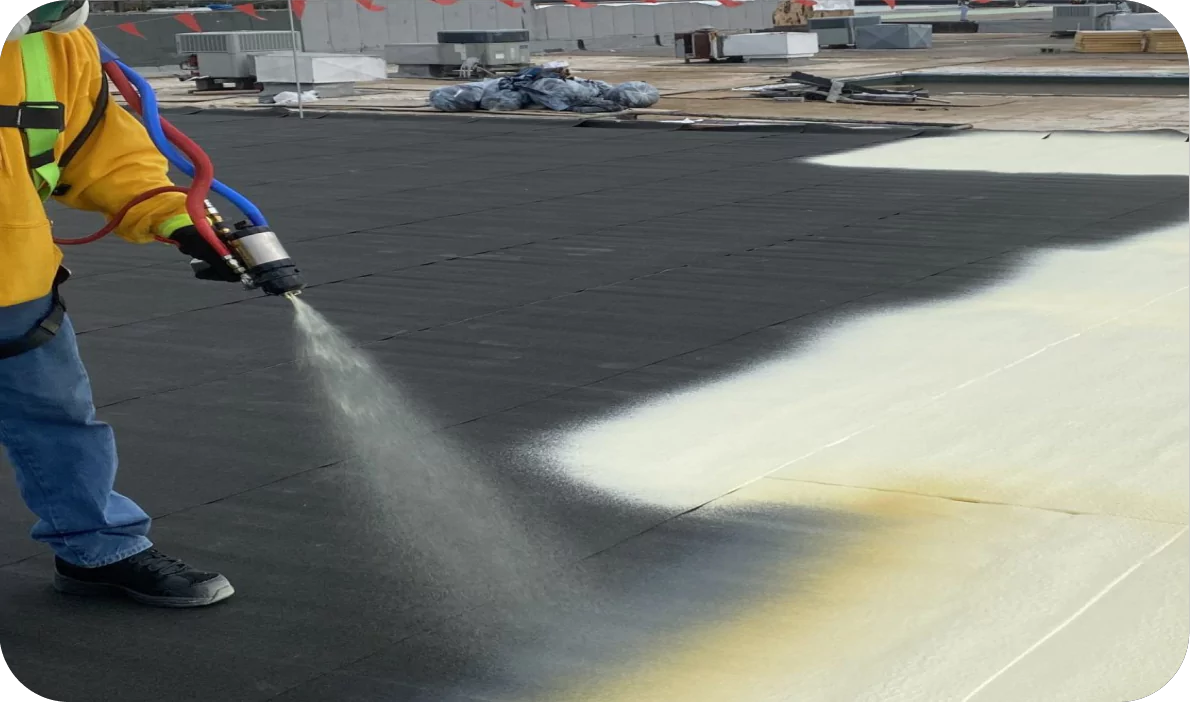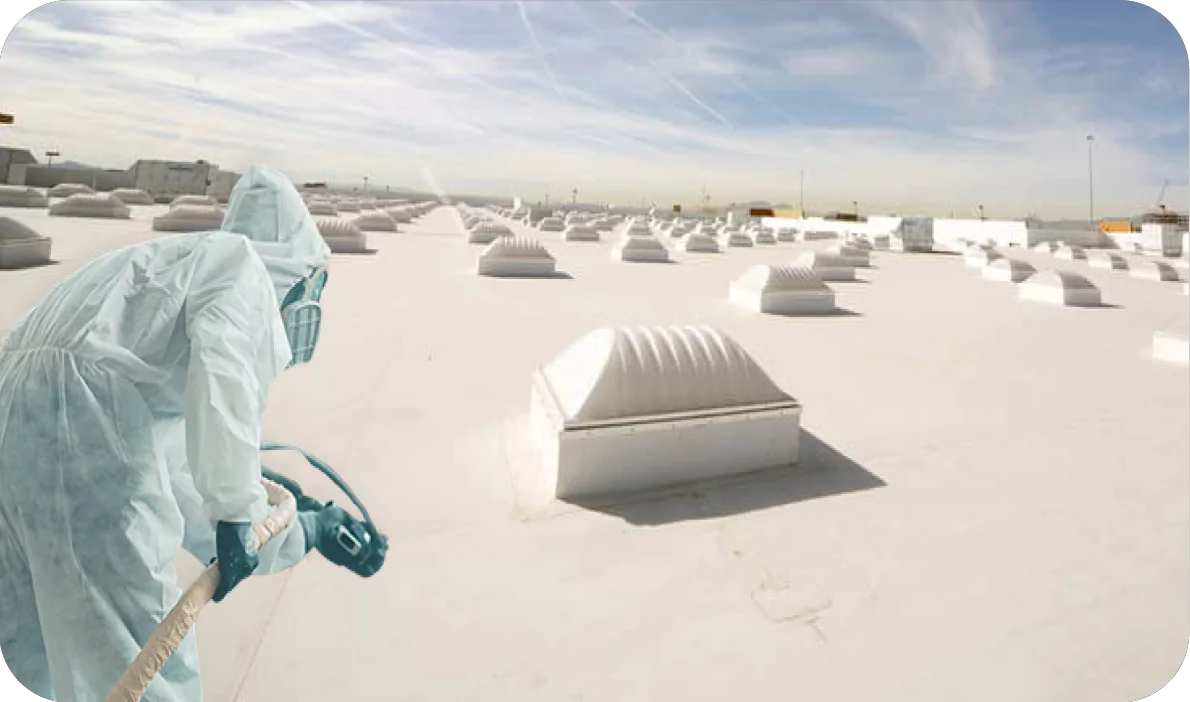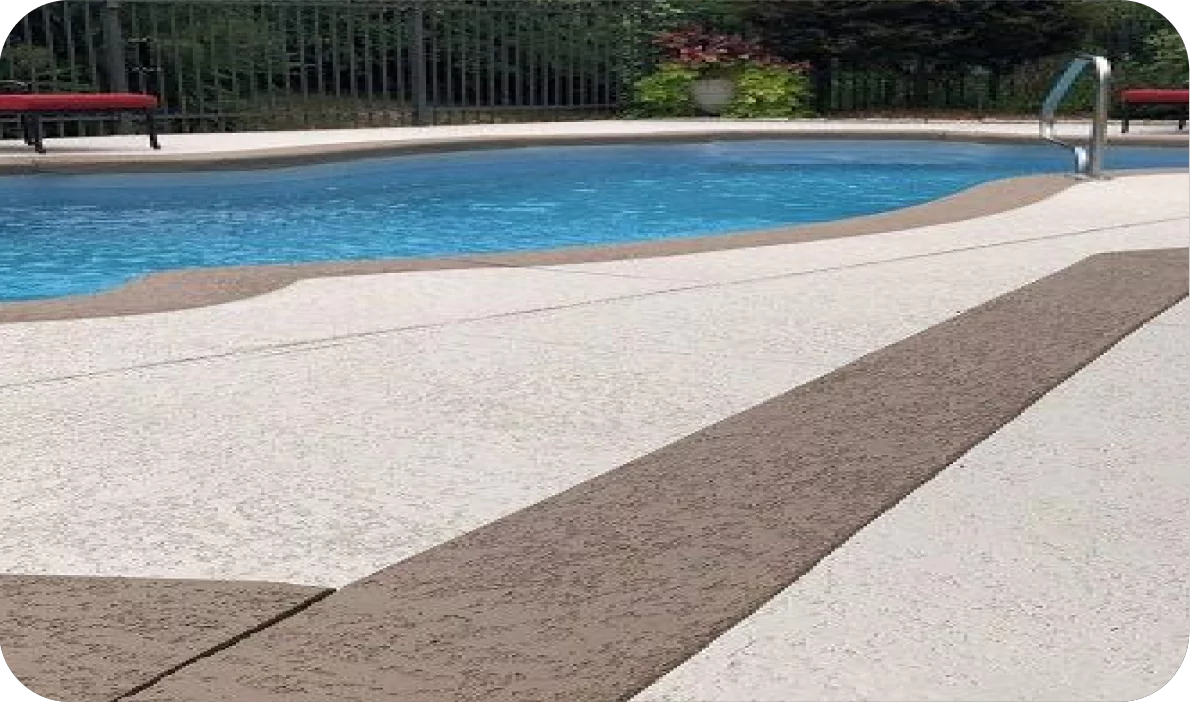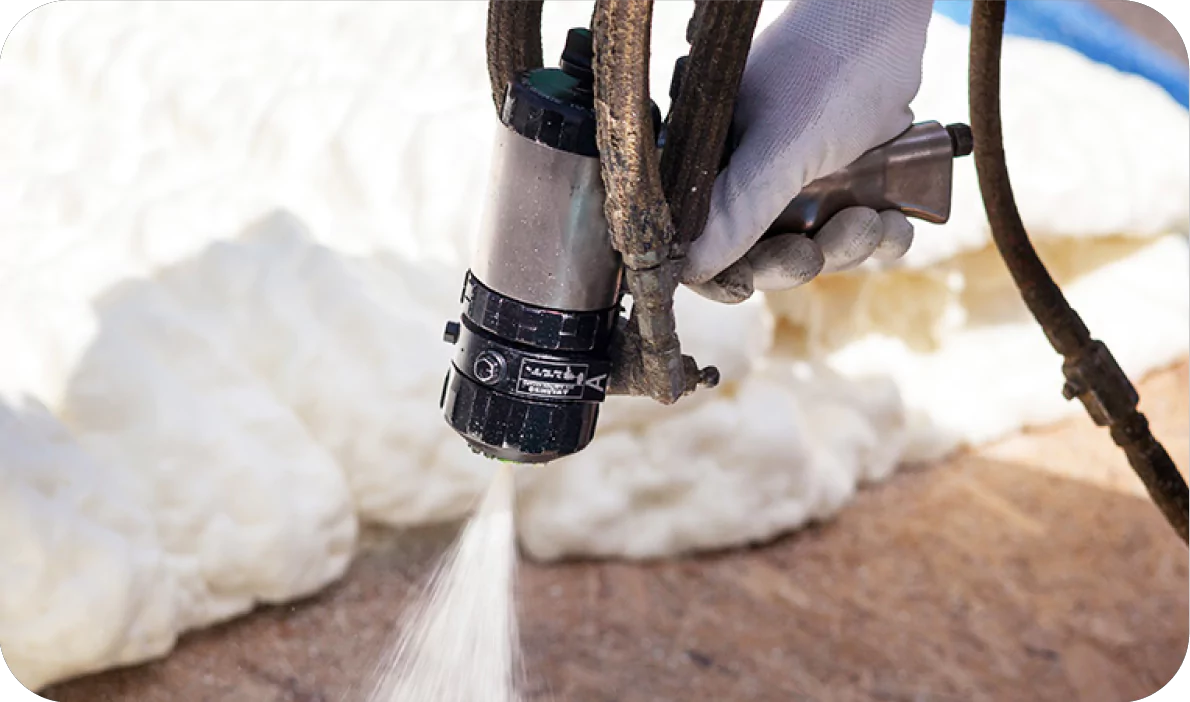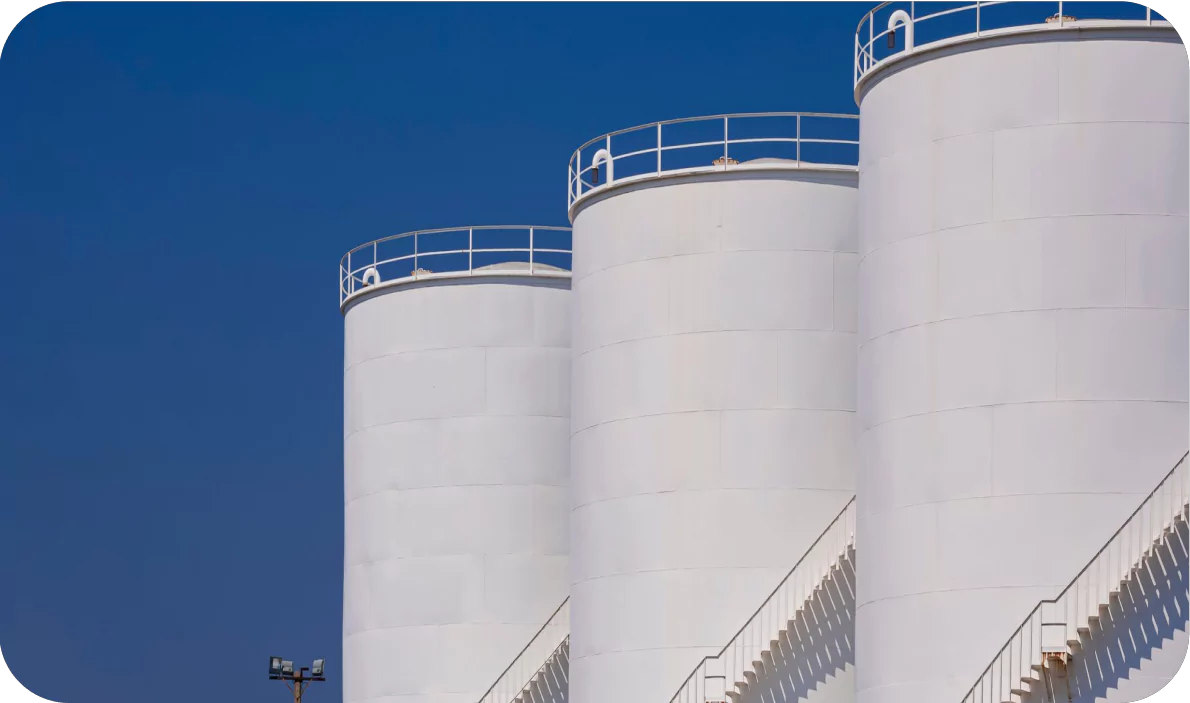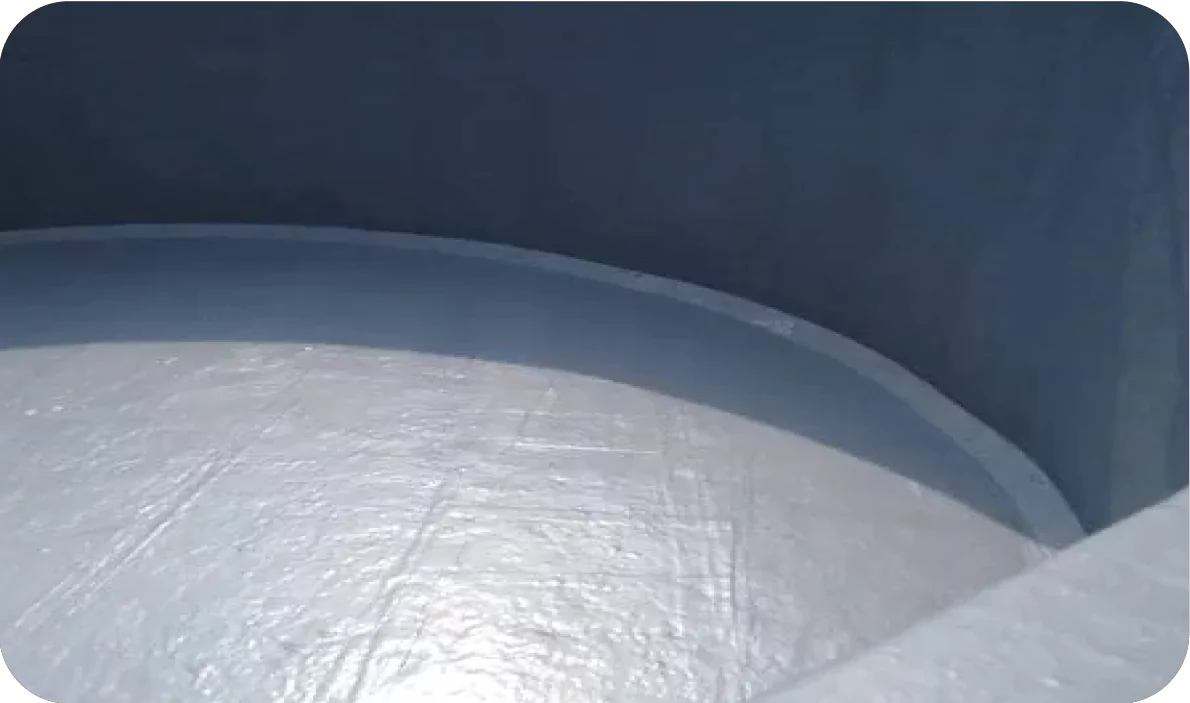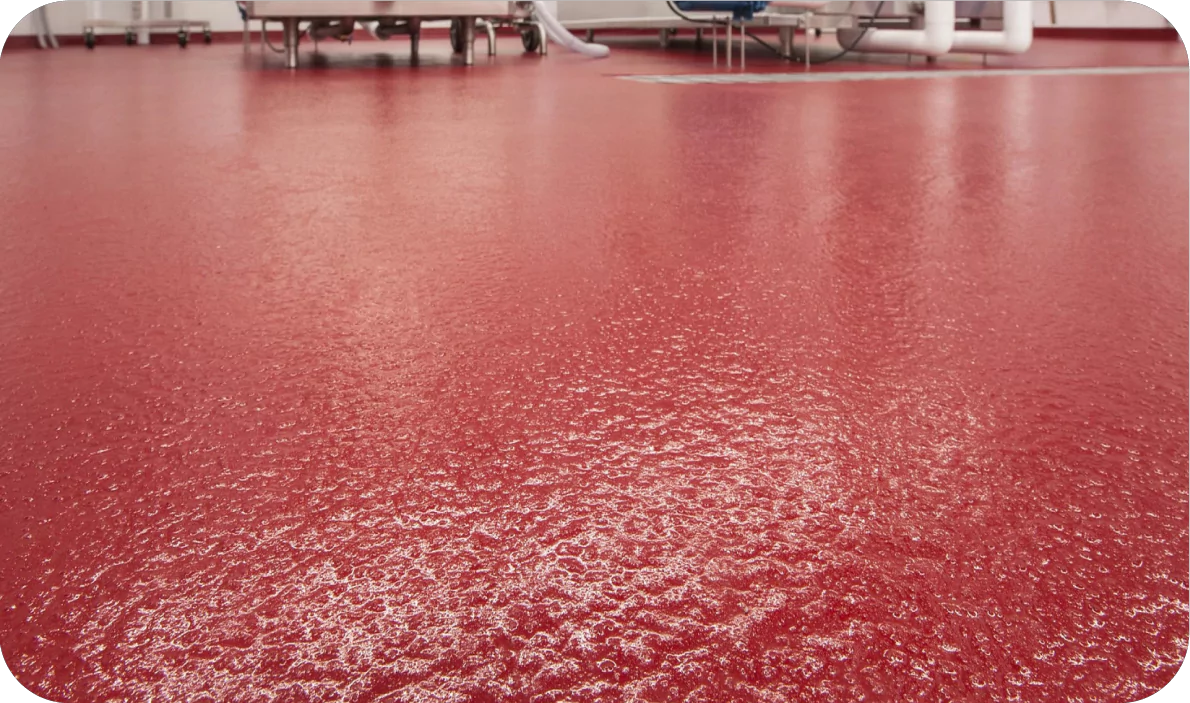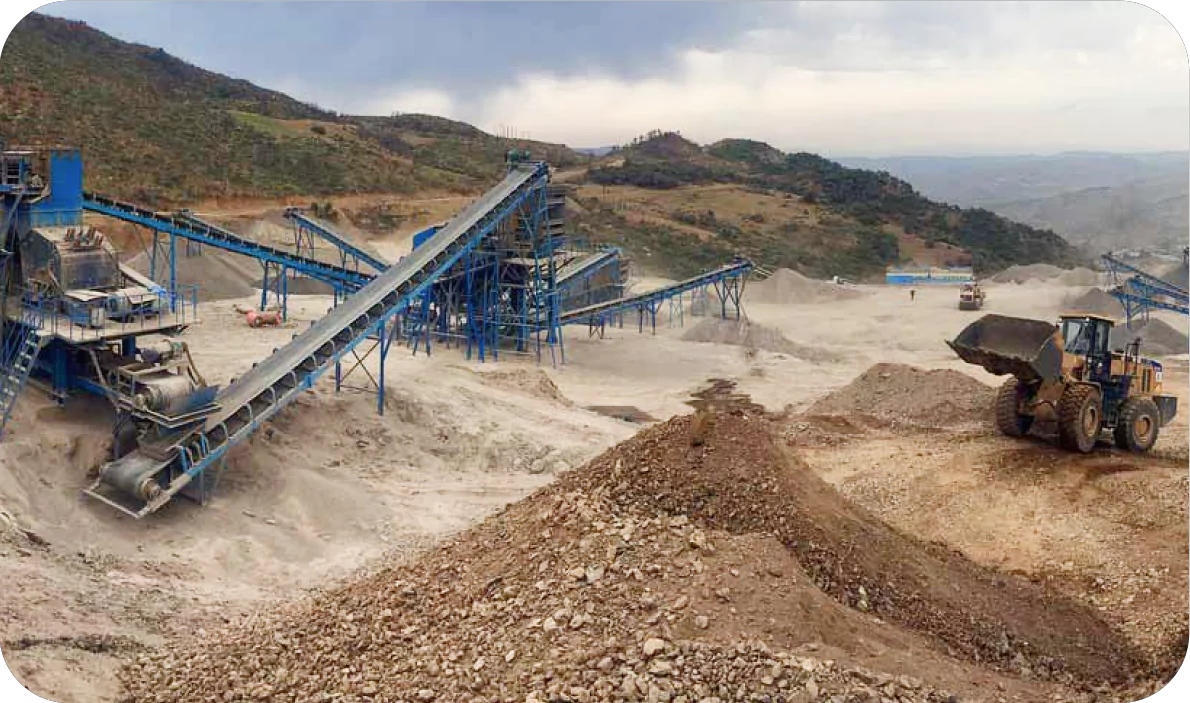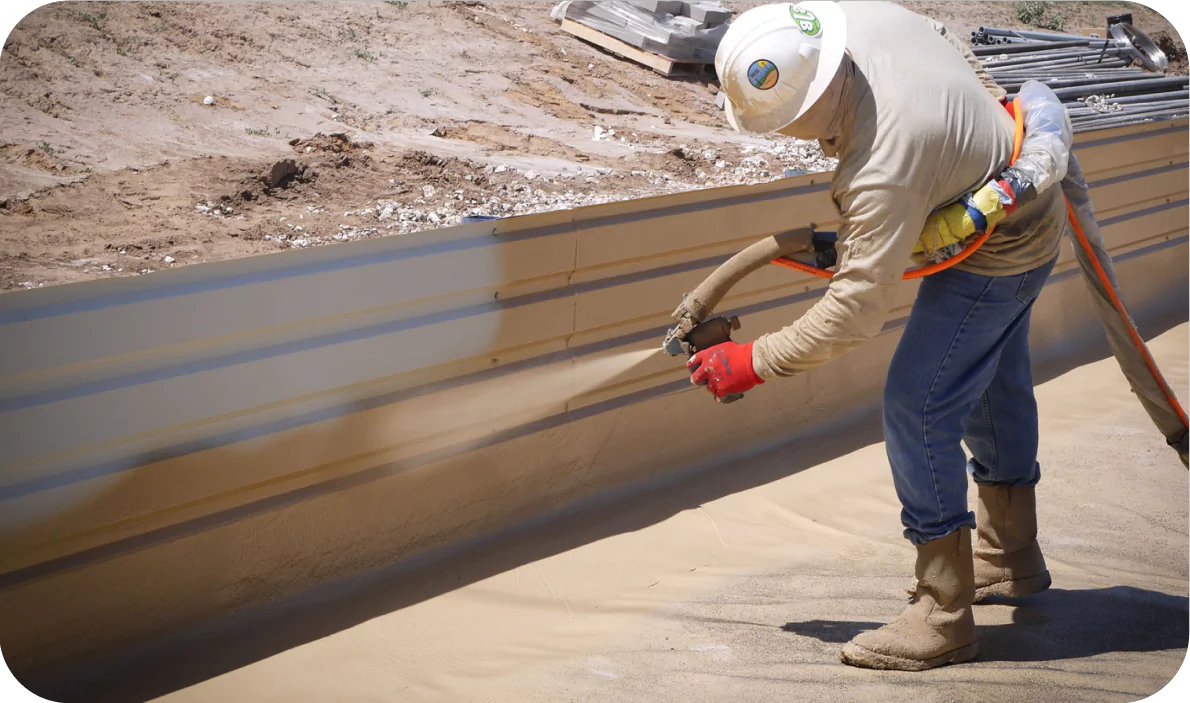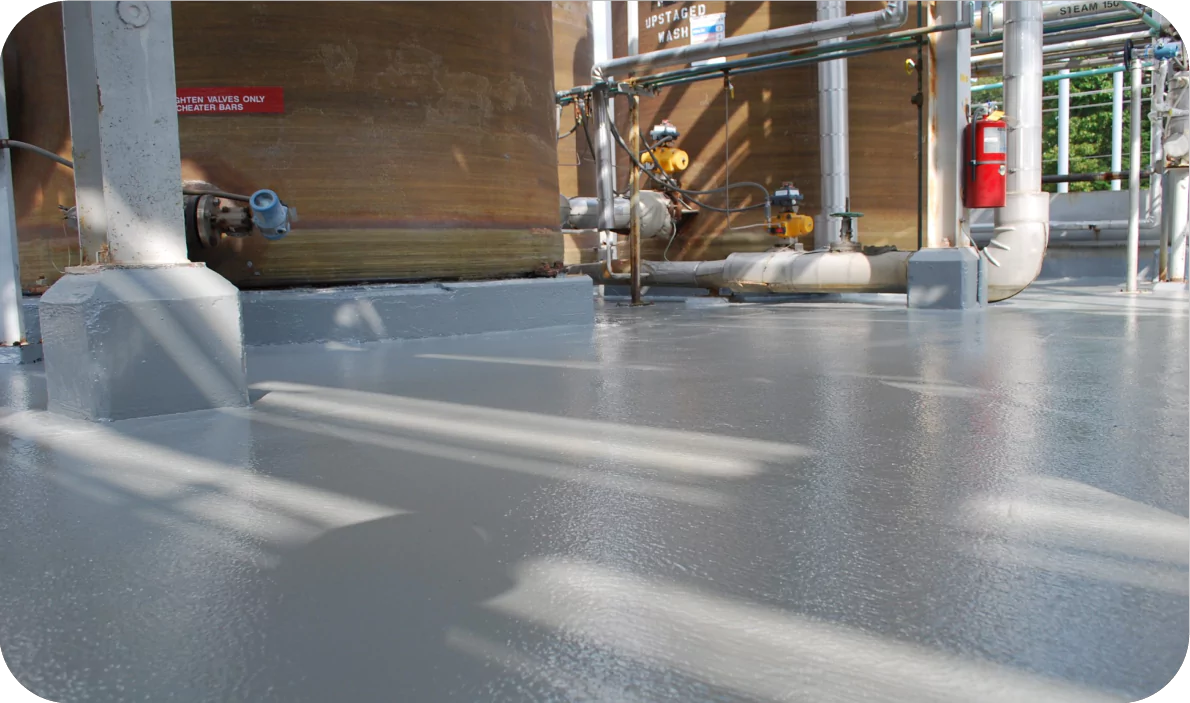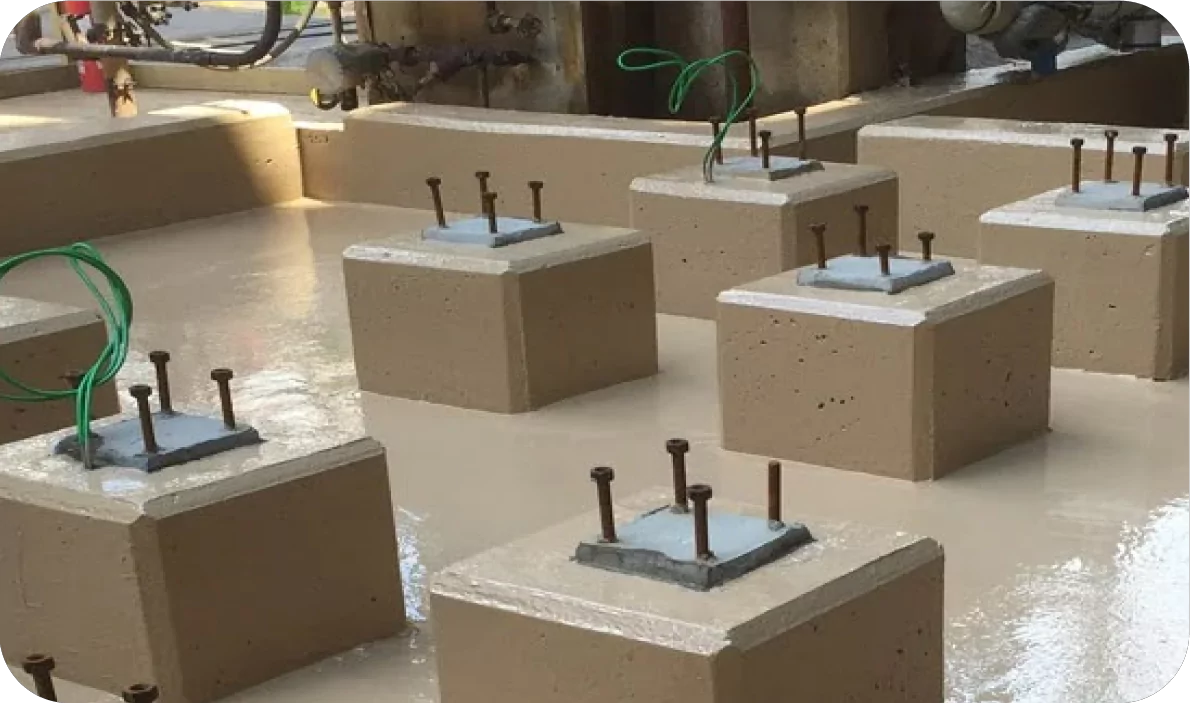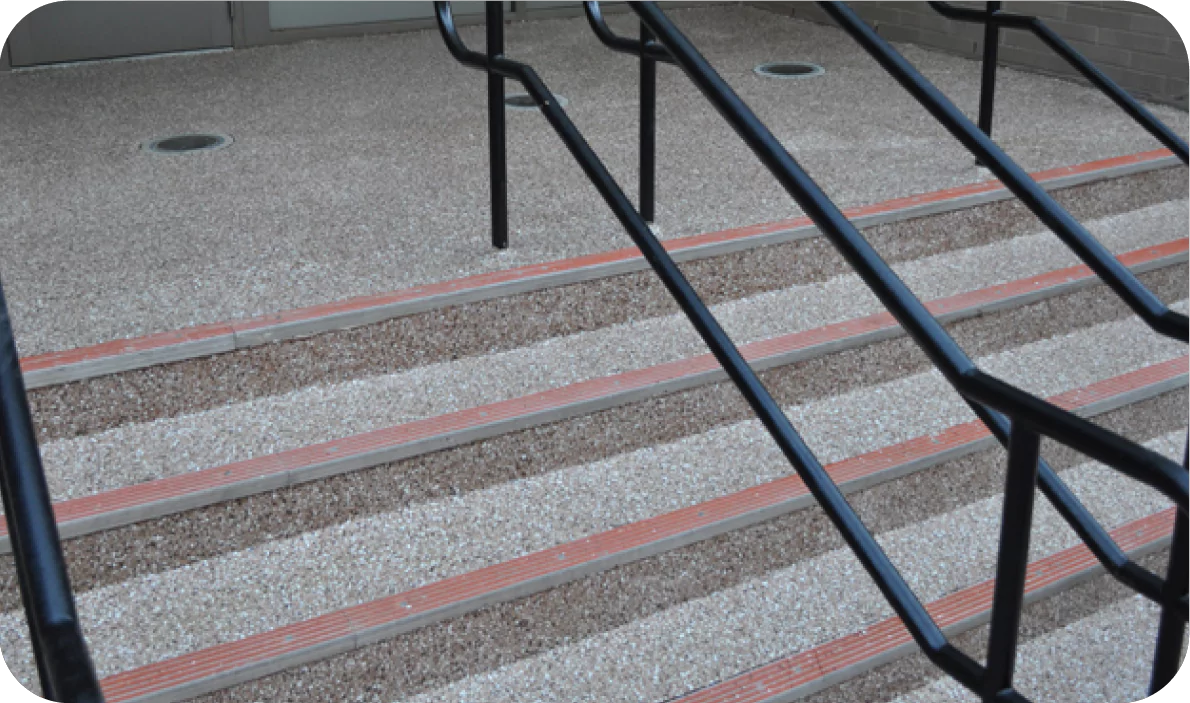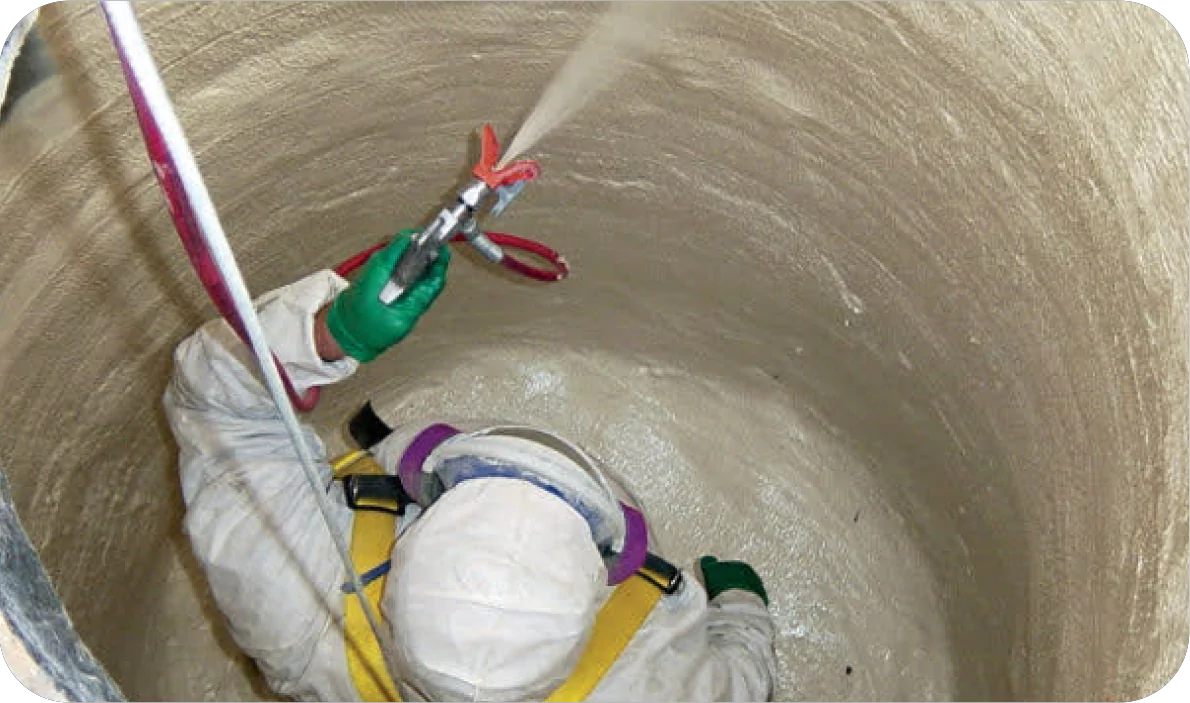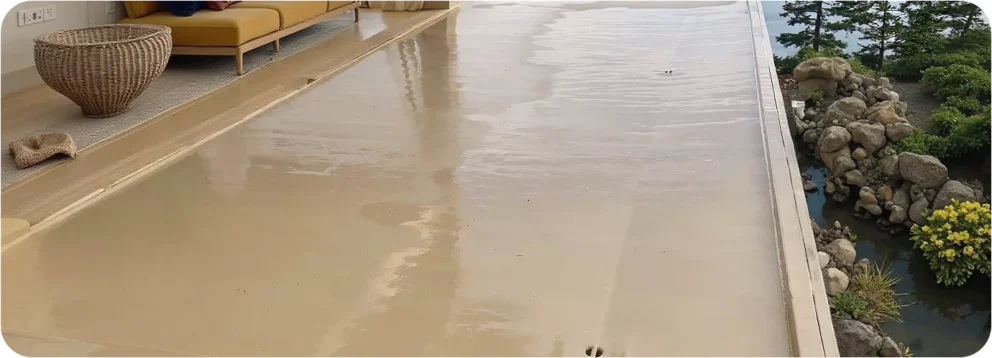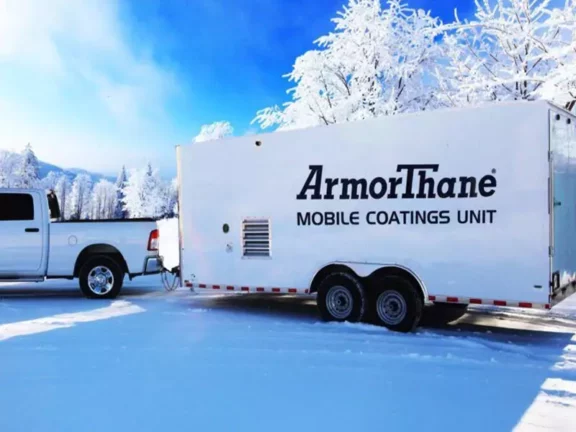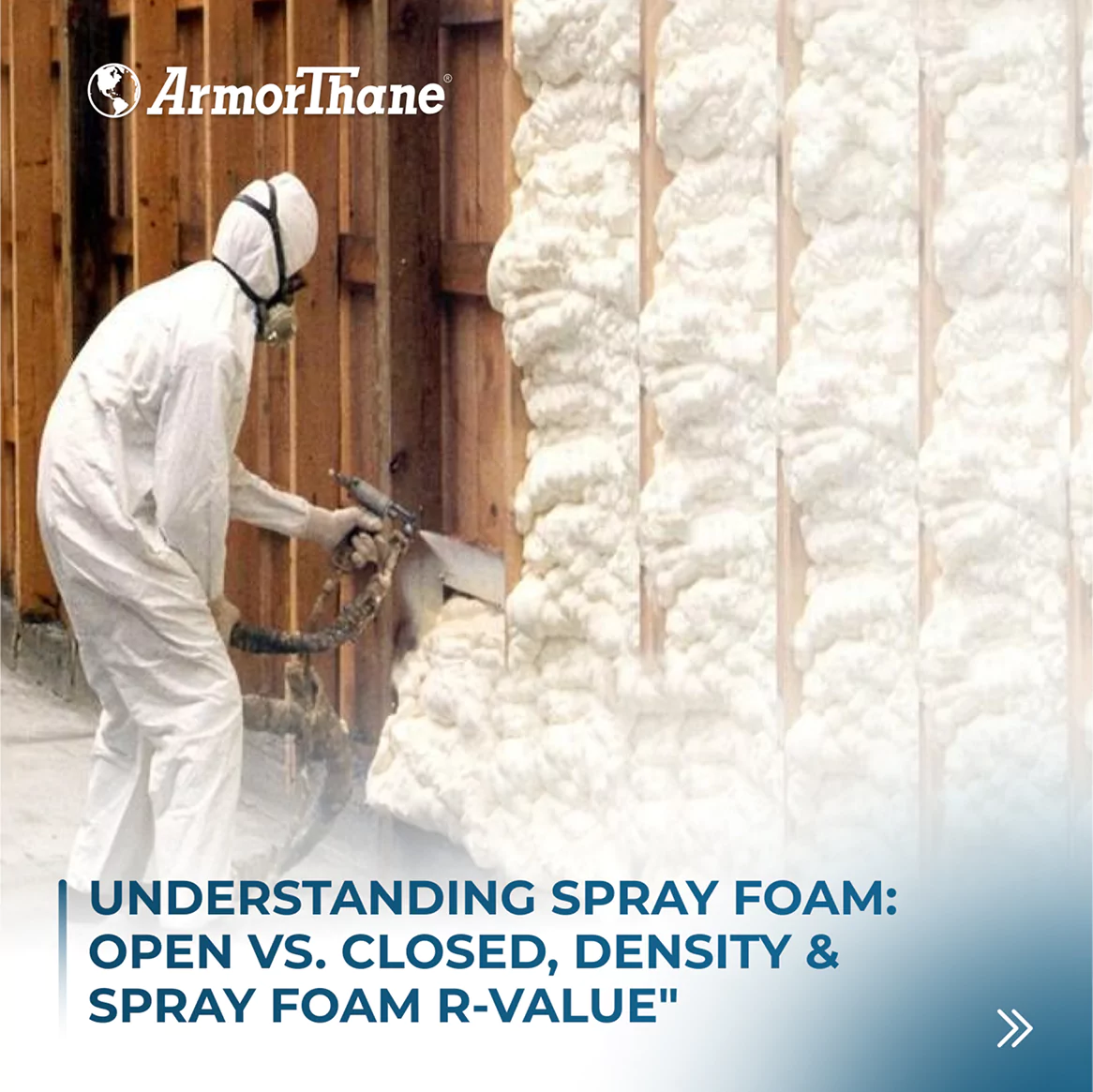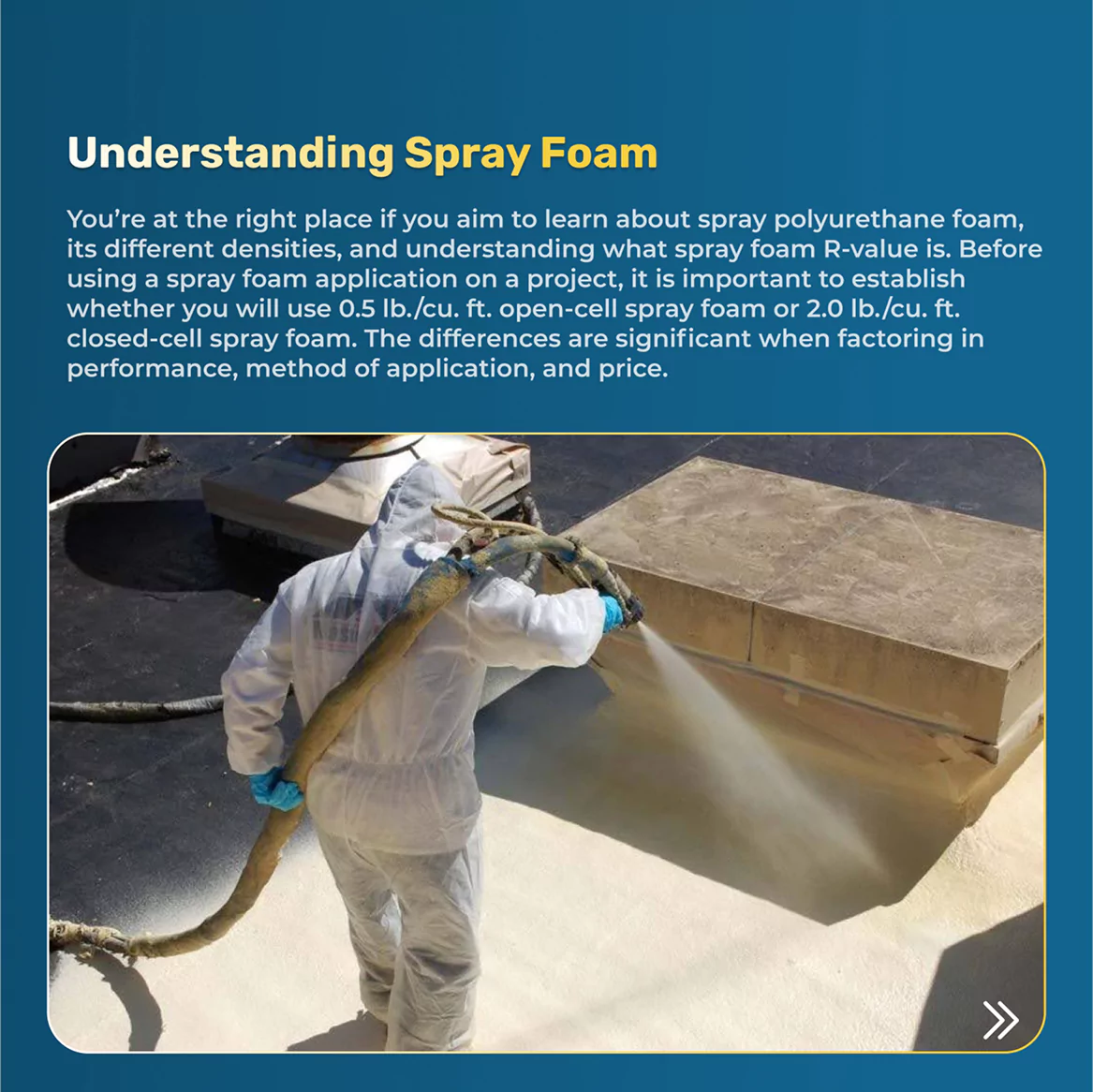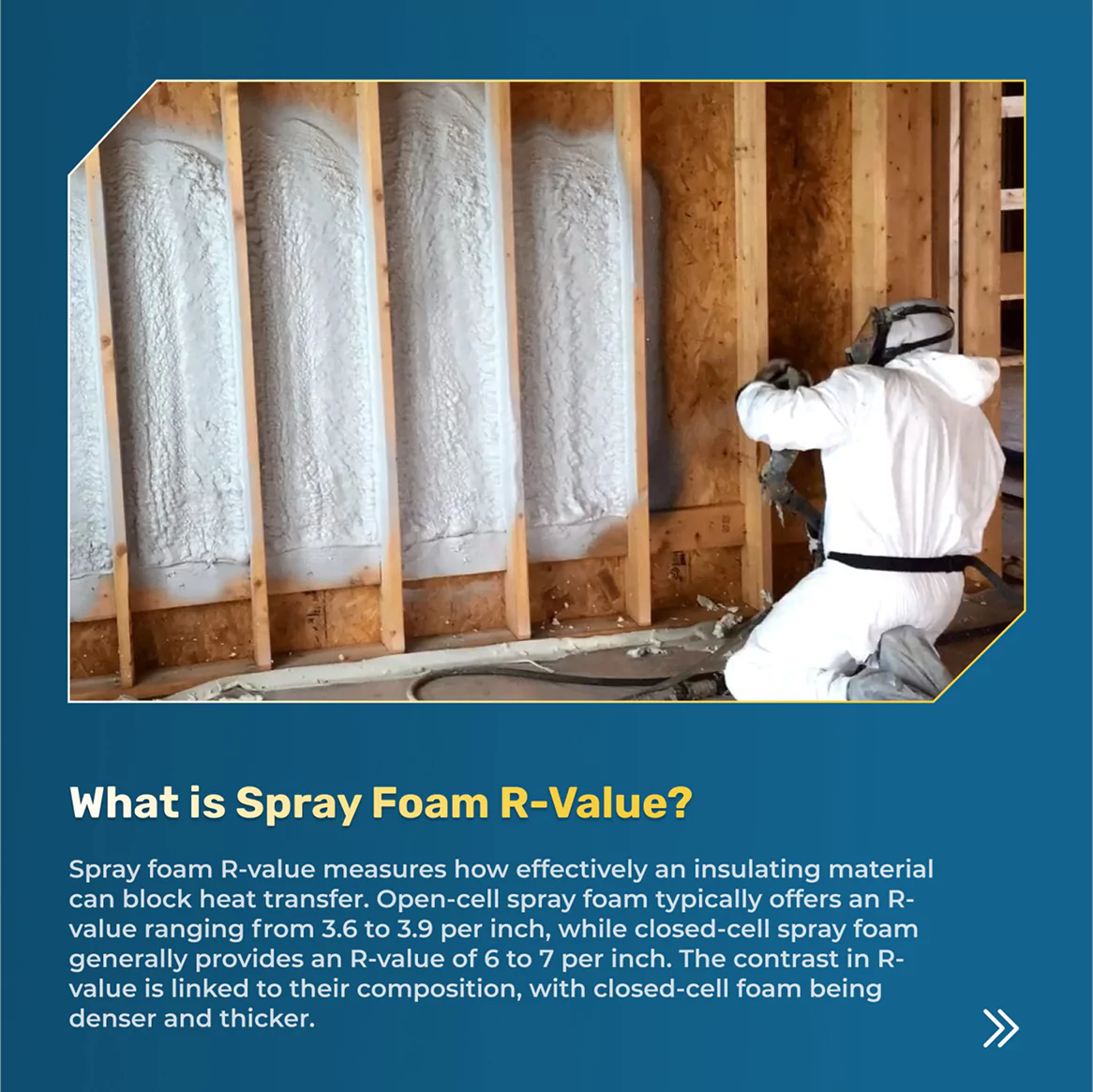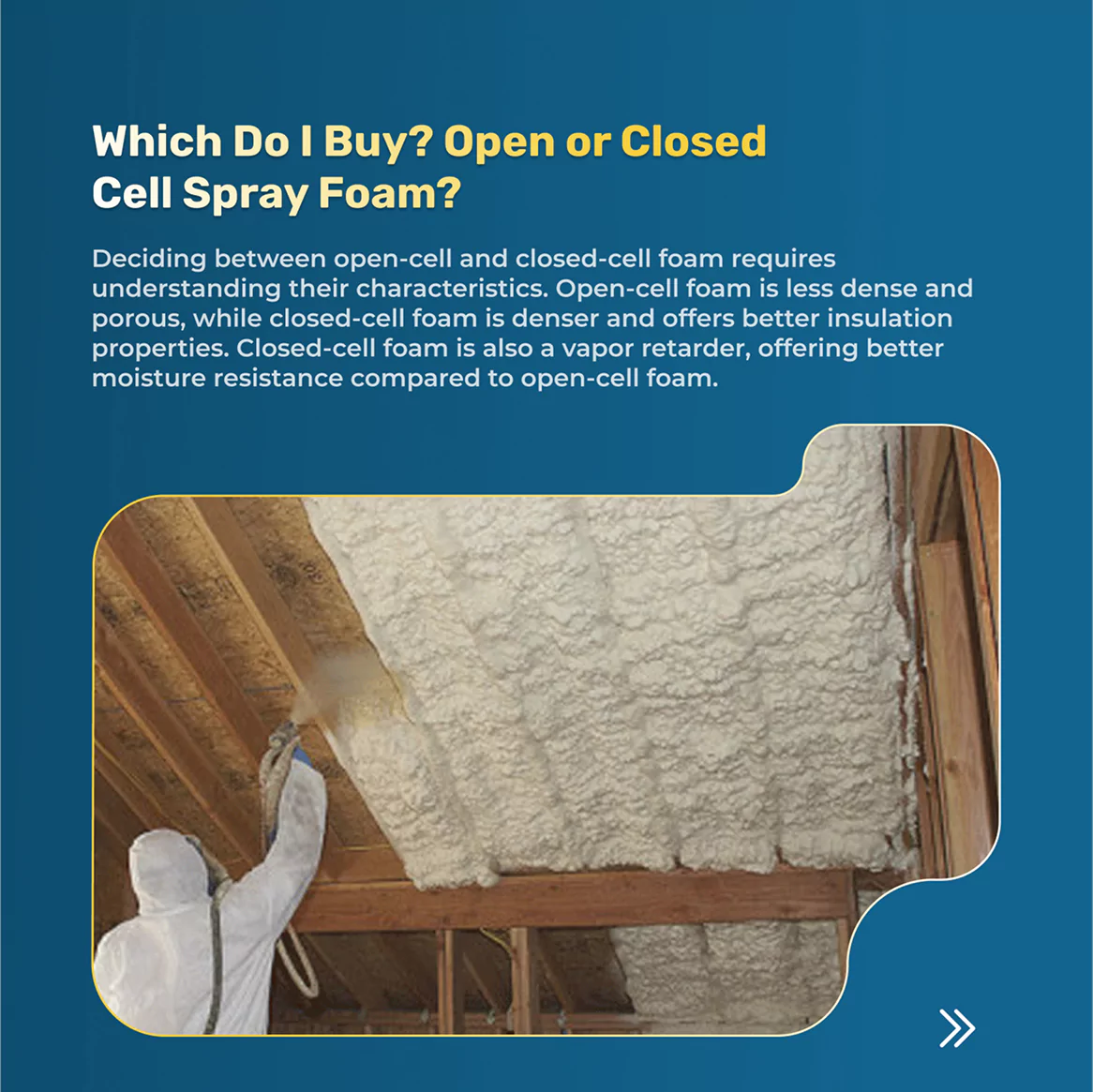SPRAY FOAM
R-VALUE
The superiority of spray foam insulation is most concisely captured by the spray foam R-value, which is far higher than most competing insulation technologies. In construction and insulation work, it’s a top choice for professionals seeking energy efficiency without suffering from a compromise in performance. Materials systems like spray polyurethane foam are applied as a liquid that expands into a foam, creating an air seal and thermal barrier in one motion. As the world’s one-stop shop for everything polyurea and polyurethane, we’re here to share everything you need to know about the spray foam R-value in one convenient place. We’ll explore the differences between open-cell vs. closed-cell spray foam, R-values per inch of thickness, and the benefits of spray foam in various applications – from wall cavities and crawlspaces to roofing systems – to help you choose the right solution for your specific needs, and navigate a complex topic with the confidence of a professional.
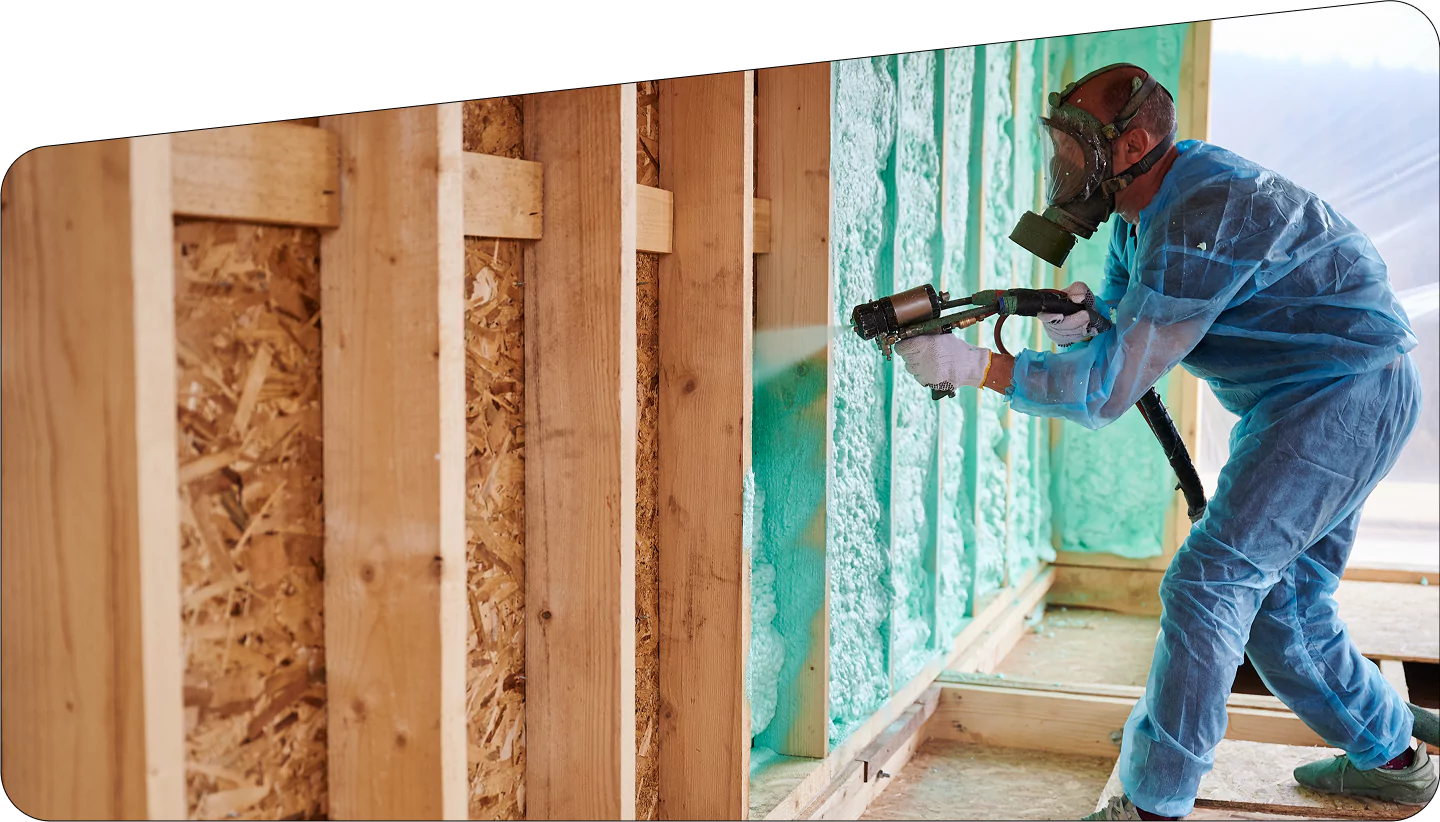
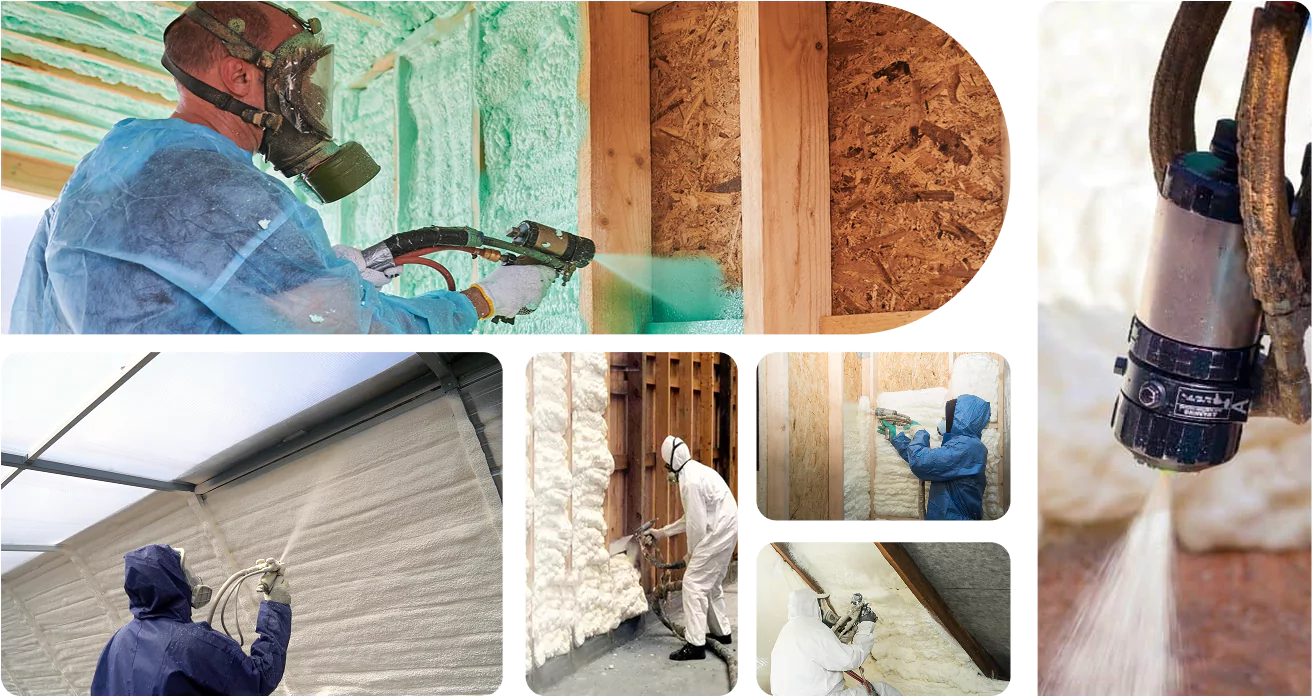
WHAT EXACTLY IS THE SPRAY-FOAM R-VALUE?
WHAT EXACTLY IS THE SPRAY-
FOAM R-VALUE?
The R-value (spray foam R-value) is a measure of thermal resistance – the higher the R-value, the better the material insulates by resisting conductive heat flow. In other words, an insulation’s R-value indicates how effectively it slows down heat loss (or heat gain) through a given thickness, which is why every type of insulation material has an R-value per inch of thickness. Spray foam insulation is often favored because it delivers higher R-values per inch compared to many other insulation products. This means a thinner layer of closed-cell spray foam can achieve the same thermal performance as a much thicker layer of fiberglass or cellulose; it also means for the same thickness, spray foam provides far better insulation, inch per inch, gram per gram. But remember, the R-value is cumulative with thickness – each inch of thickness adds more resistance. So installing 2 inches of a material roughly doubles the total R-value (e.g., 2 inches of closed-cell foam ~ R-12+). However, real-world insulation performance isn’t only about R-value; factors like air movement, moisture, and installation quality also impact insulation effectiveness, but spray foam addresses several of these factors simultaneously. Fibrous insulation might allow air movement through gaps, while spray foam expands to fill voids and adheres to surfaces, reducing air flow and convection within cavities. Spray foam gets you both high thermal insulation value and air sealing in one product.
SPRAY FOAM R-VALUES OF
OPEN-CELL VS. CLOSED-
CELL FORMULATIONS
SPRAY FOAM R-VALUES OF OPEN-CELL VS. CLOSED-CELL FORMULATIONS
There are two types of spray foam, which each have different properties and thus a different standard range of R-value of spray foam insulation:
OPEN-CELL
Open-cell spray foam insulation is essentially the opposite of closed-cell foams; they’re low-density, and as the name implies, the cell structure is open– the tiny foam cells are not fully closed, which makes the foam softer and less dense, with open-cell foams typically having an R-value around R-3.5 per inch; while this R-value per inch is lower than closed-cell foam, open-cell foam may still be a superior solution for many applications. It expands greatly (up to 100-150 times its liquid volume), enabling it to fill wall cavities and crevices effectively, and open-cell foam also creates an excellent air seal, stopping drafts and air infiltration through cracks. In fact, at sufficient thickness, it’s considered air-impermeable, meaning it blocks air flow very well (almost entirely).

This contributes to significant energy savings by reducing heat loss and uncontrolled air exchange, however, open-cell foam is vapor-permeable – it’s not a vapor barrier. Water vapor can diffuse through it (it behaves as a vapor retarder at best), and because it can absorb moisture, open-cell foam is generally not recommended for exposed outdoor applications or in contact with water. It performs best for interior walls, attic rafters, and other areas where the ability to breathe (allow some drying) is beneficial and higher R-values per inch are not critical. Last but not least, open-cell foam also provides sound-dampening benefits, making it useful for noise reduction in interior walls.
CLOSED-CELL
Closed-cell spray foam is a denser, rigid foam with cells that are fully closed and packed together, giving it a firm structure. Closed-cell foam boasts a much higher R-value – roughly R-6 to R-7 per inch of thickness – making it one of the most thermally efficient insulation products available on the market, period. The closed cell structure, filled with a special gas (blowing agent), is key to its performance: the trapped gas has lower thermal conductivity than air, which increases the foam’s insulating power. This type of spray foam is an effective vapor barrier as well; at about 2–3 inches thickness, it becomes nearly impermeable to moisture, while closed-cell foam is also hydrophobic (does not absorb water), adding a layer of moisture protection to building assemblies.
Another added benefit is its contribution to structural strength – once cured, closed-cell foam can substantially increase the structural integrity of walls and roofs. It adheres strongly to framing and sheathing, effectively gluing building components together, and for this reason, closed-cell is often chosen for areas like rim joists, crawlspace walls, and exterior walls where both insulation and structural enhancement are desired. The trade-offs: closed-cell foam is more expensive and its density means you use more material per board foot, but for applications requiring maximum R-value or exposure to moisture, closed-cell spray foam insulation is usually the preferred type of spray foam insulation.
Another added benefit is its contribution to structural strength – once cured, closed-cell foam can substantially increase the structural integrity of walls and roofs. It adheres strongly to framing and sheathing, effectively gluing building components together, and for this reason, closed-cell is often chosen for areas like rim joists, crawlspace walls, and exterior walls where both insulation and structural enhancement are desired. The trade-offs: closed-cell foam is more expensive and its density means you use more material per board foot, but for applications requiring maximum R-value or exposure to moisture, closed-cell spray foam insulation is usually the preferred type of spray foam insulation.
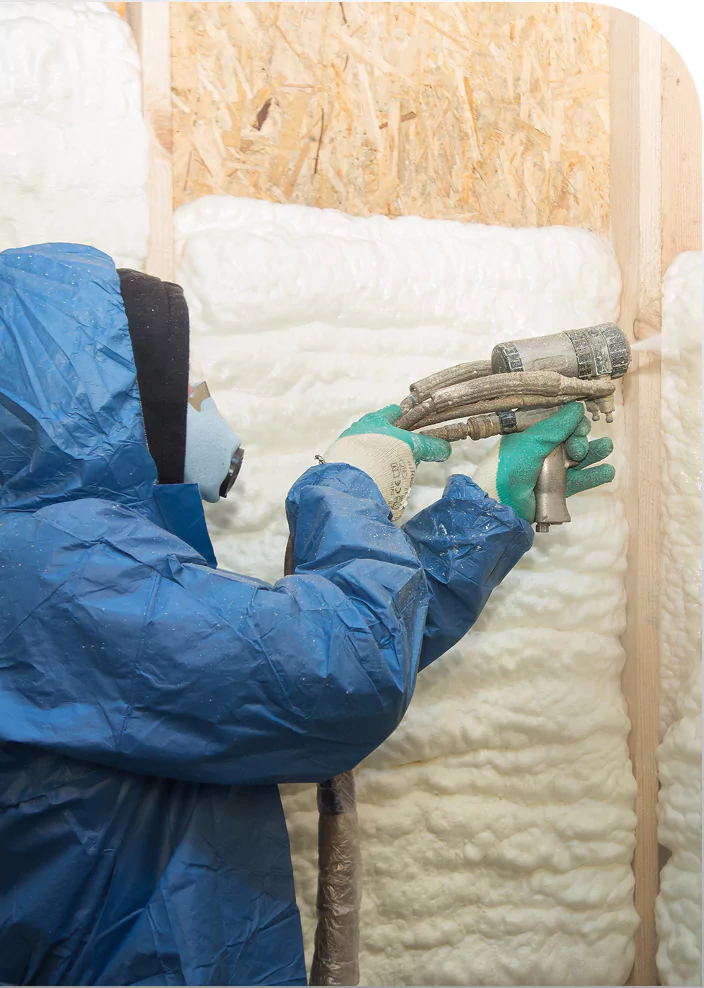
COMPARING SPRAY FOAM TO OTHER INSULATION TYPES
COMPARING SPRAY FOAM TO OTHER
INSULATION TYPES
Modern builders have a wide range of insulation products to choose from, so it’s important to understand how spray foam stacks up against some types of insulation commonly used in terms of R-value and other performance characteristics:
-
Fiberglass Insulation:
Fiberglass has an R-value around 2.5 to 4 per inch, depending on density. It’s inexpensive and widely used, but it’s air-permeable – meaning drafts can pass through it, and it does not act as an air seal. Fiberglass often requires a separate vapor barrier (like poly sheeting) in cold climates but by contrast, closed cell insulation (spray foam) provides higher R per inch and an integral air barrier. Fiberglass is also less effective in small or irregular spaces since it must be cut to fit around penetrations, whereas spray foam conforms to any shape -
Cellulose Insulation:
Cellulose (usually a loose-fill made of recycled paper fibers) offers roughly R-3.2 to R-3.8 per inch. It can settle over time, potentially reducing its insulation’s R-value if not properly installed. Like fiberglass, it doesn’t inherently stop airflow or moisture, whereas spray foam, in comparison, stays in place without settling and significantly reduces air infiltration. Cellulose is often used in attics or closed wall cavities (blown behind netting or into drill-and-fill applications), but it may not provide the air seal that spray foam does. -
Rigid Foam Insulation (Foam Board):
Rigid foam boards (such as EPS, XPS, or polyisocyanurate) have R-values ranging from about R-4 per inch (EPS) to R-5 (XPS) and up to R-6 or so for polyiso (in optimal conditions). These boards are useful for continuous insulation on exterior walls or above roof decks to reduce thermal bridging (since they cover framing members). However, installing rigid foam requires careful sealing of joints and penetrations to prevent air infiltration and moisture issues. Spray foam can be seen as a custom, on-site version of rigid foam – it effectively creates a continuous insulated air-tight layer without seams. In roofing systems, sprayed closed-cell foam can replace the need for layered rigid boards, and it adheres without the need for fasteners (eliminating those points of conductive heat flow through fastener penetrations).
WALLS, ATTICS, CRAWLSPACES, AND MORE
Spray foam’s versatility as a building material allows it to be used in many different parts of a home or commercial building:
EXTERIOR WALLS & WALL CAVITIES
In exterior wall cavities, spray foam maximizes insulation within the stud space; closed-cell foam is often favored for walls because its higher R-value can meet code requirements in narrower cavities, and it adds rigidity and water resistance to the wall. It effectively seals around plumbing and electrical penetrations, stopping drafts in wall cavities that lead to heat loss. Open-cell foam can also be used in walls (particularly in moderate climates or where a vapor barrier is less critical), and either type will outperform fiberglass insulation in wall applications due to the air seal—fiberglass or batts may leave gaps around wires or framing, whereas foam fills every nook. Thus, spray foam can achieve a higher effective R-value for the wall system and reduced thermal bridging when closed-cell foam glues to studs and sheathing. In new homes, many builders use spray foam in walls to achieve superior energy performance and tight construction.
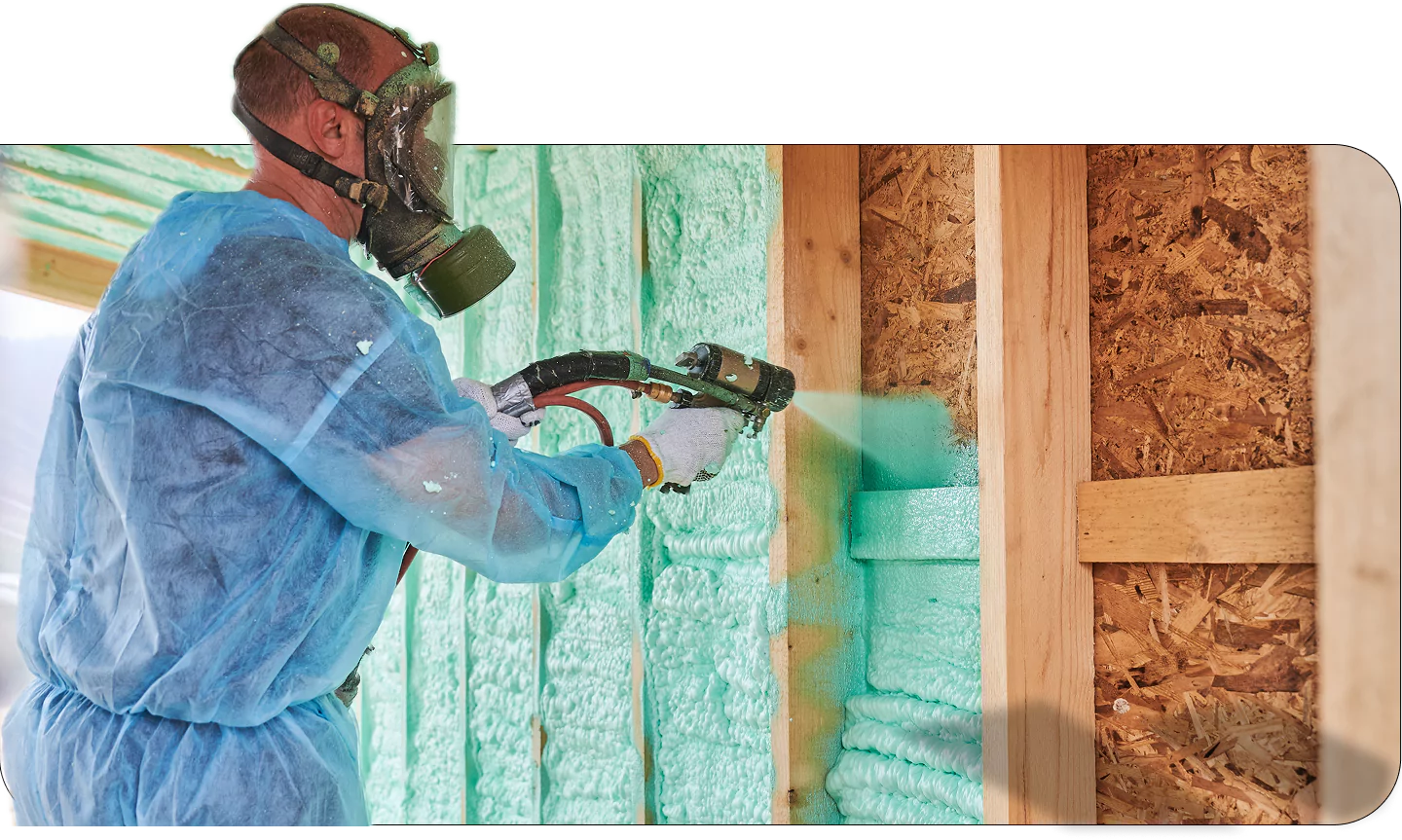
ATTICS & CEILINGS
Spray foam can be applied between roof rafters (along the underside of the roof deck) to create an unvented, conditioned attic space. Open-cell spray foam is commonly used for attic roofing systems in homes because it’s cost-effective for the thick layers needed, and it also allows some drying of the roof deck thanks to vapor permeability, which can be useful in certain climates. Closed-cell foam in attics offers maximum R per inch – great for limited-space scenarios or where you want additional moisture control. By insulating at the roofline, the attic is kept warmer in winter and cooler in summer, which also benefits any HVAC equipment in the attic.
Using spray foam in attics often eliminates the need for a separate attic radiant barrier, since the foam layer is in direct contact with the roof deck, reducing heat transfer. However, some attic designs may still include radiant barriers or reflective roof coatings on top of the deck to further cut down radiant heat from the sun. In either case, a spray-foamed attic will dramatically reduce heat loss in winter and heat gain in summer compared to a traditional vented attic with loose-fill insulation on the attic floor, leading to noticeable energy savings and improved comfort in the rooms below.
Using spray foam in attics often eliminates the need for a separate attic radiant barrier, since the foam layer is in direct contact with the roof deck, reducing heat transfer. However, some attic designs may still include radiant barriers or reflective roof coatings on top of the deck to further cut down radiant heat from the sun. In either case, a spray-foamed attic will dramatically reduce heat loss in winter and heat gain in summer compared to a traditional vented attic with loose-fill insulation on the attic floor, leading to noticeable energy savings and improved comfort in the rooms below.
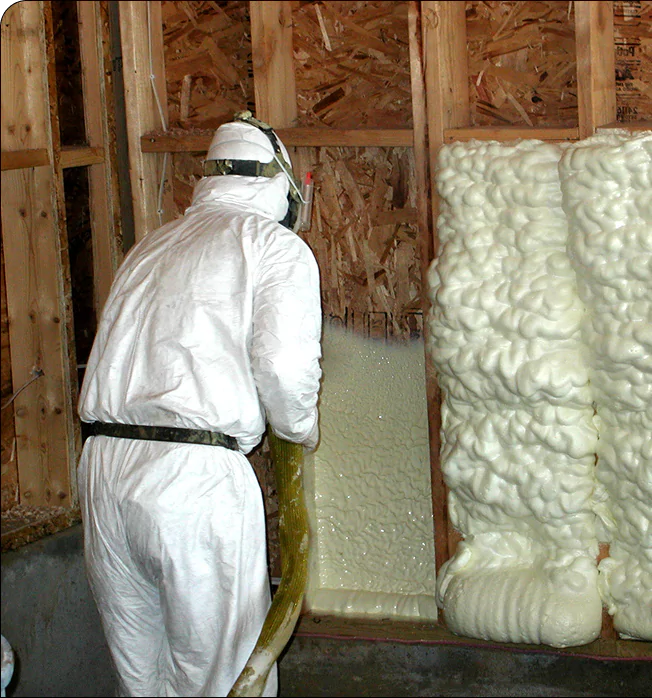
CRAWLSPACES & BASEMENTS
For crawlspaces, especially crawlspaces that are enclosed (unvented), closed-cell spray foam is often the ideal solution. It can be applied to crawlspace walls and the rim joist area to insulate and act as a moisture barrier in one step; insulating the perimeter of a crawlspace (instead of the crawlspace ceiling), the crawlspace becomes a conditioned space, keeping floors above warmer and reducing humidity coming up from the ground. The foam’s vapor barrier qualities help keep ground moisture from migrating into the building, and in basements, closed-cell foam on foundation walls adds insulation while preventing condensation on the cool concrete surfaces.
Open-cell foam is usually not used in ground-contact areas because it can absorb water. However, open-cell might be used on basement ceiling joists or the band joists for sound damping or if moisture is well-controlled; rim joists (the band joist around the perimeter between floors) are notorious for air leakage, so spraying closed-cell foam in rim joists both insulates these small cavities and seals all the cracks – an area that’s very hard to seal with fiberglass or rigid board. Even a couple of inches of closed-cell foam in the rim joist area can stop cold drafts and heat loss in a home’s perimeter.
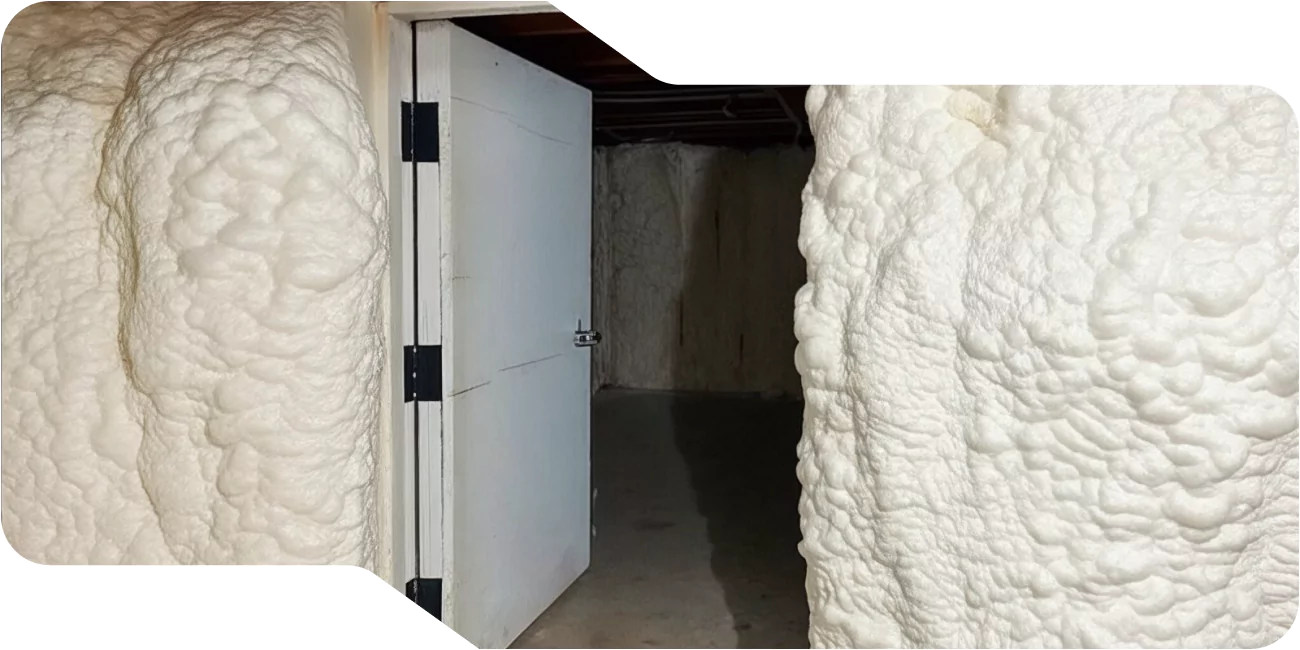
INTERIOR WALLS &
SPECIALTY USES
While not primarily for thermal insulation, open-cell spray foam is sometimes sprayed in interior walls or between floors for sound attenuation. Its ability to reduce sound transmission (due to its open cell structure absorbing sound waves) is an added benefit in media rooms, offices, or between living units in multi-family construction. Spray foam (usually closed-cell) is also used around window and door frames (minimal expanding low-pressure formulations) to air-seal gaps, and in irregular areas like vaulted ceiling corners, bay windows, or any custom framing areas where cutting batts would be difficult. These foam air-seals improve comfort and eliminate drafts, contributing to overall efficiency of the insulation work.
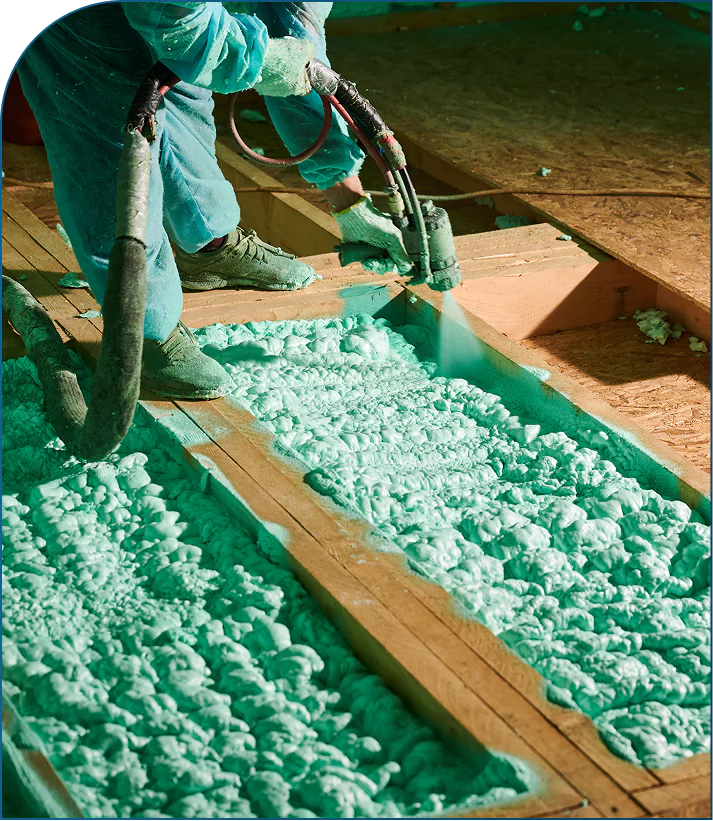
latest news & bLOGS
FOR THE HIGHEST SPRAY FOAM R-VALUE AND THE
BEST COATINGS PARTNERS, CHOOSE ARMORTHANE
FOR THE HIGHEST SPRAY FOAM
R-VALUE AND THE BEST COATINGS
PARTNERS, CHOOSE ARMORTHANE
Spray foam insulation offers a unique combination of insulation properties (high R-value, air sealing, and moisture control) that can substantially improve energy efficiency and building durability. When selecting between open-cell and closed-cell or planning a spray foam project, consider the specific requirements of your building – climate zone, specific needs for vapor control, budget, and whether structural reinforcement is a priority. Both types of spray foam can contribute to lower energy bills, better comfort, and a more resilient structure when properly applied in the right places.
ArmorThane is a trusted name in the paints and coatings industry, and a world renowned expert in all things polyurethane and polyurea technologies; we’re the perfect partner to help you with your next spray foam project. We have deep expertise in polyurea coatings and spray polyurethane foam, and are ready to become your reliable industry expert for high-performance insulation solutions backed by proven technology and industry know-how. All you need to do is give us a call or fill out our contact form, and one of our 24/7 customer service or technical support team members will get back to you faster than our rapid cure coatings dry!
ArmorThane is a trusted name in the paints and coatings industry, and a world renowned expert in all things polyurethane and polyurea technologies; we’re the perfect partner to help you with your next spray foam project. We have deep expertise in polyurea coatings and spray polyurethane foam, and are ready to become your reliable industry expert for high-performance insulation solutions backed by proven technology and industry know-how. All you need to do is give us a call or fill out our contact form, and one of our 24/7 customer service or technical support team members will get back to you faster than our rapid cure coatings dry!
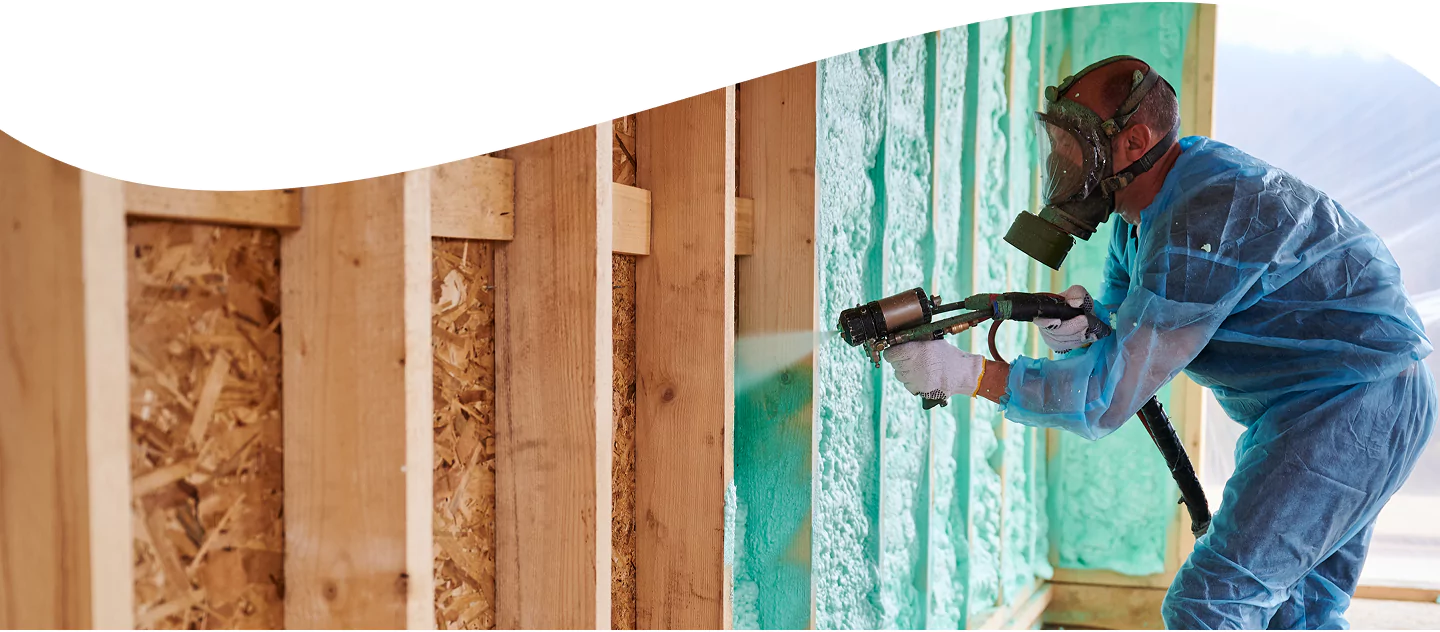
FREQUENTLY ASKED QUESTIONS
High-performance spray foam insulation is made of advanced materials technology like ArmorThane’s polyurethane. Our polyurethane spray foam is formed on site and during application, using only few precursor materials and innovative spray equipment like custom spray foam rigs. We offer both open-cell and closed-cell products, so there’s something for any insulation project.
Closed-cell spray foam can function as a vapor barrier; when applied about 2 inches thick or more, closed-cell foam becomes very resistant to moisture transfer, essentially stopping vapor diffusion entirely. This makes it suitable for use on crawlspace walls, basements, and other areas where you want to block moisture, but open-cell foam, on the other hand, is not a vapor barrier – it remains permeable to water vapor and may require an additional vapor retarder in humid or cold environments.
Spray foam improves energy efficiency in two major ways: by providing high R-value insulation and by creating an effective air seal. Its thermal resistance reduces heat loss in winter and heat gain in summer, so your HVAC system runs less to maintain comfort. At the same time, spray foam’s expansion seals cracks and gaps, reducing air infiltration which can account for a large portion of energy waste.
